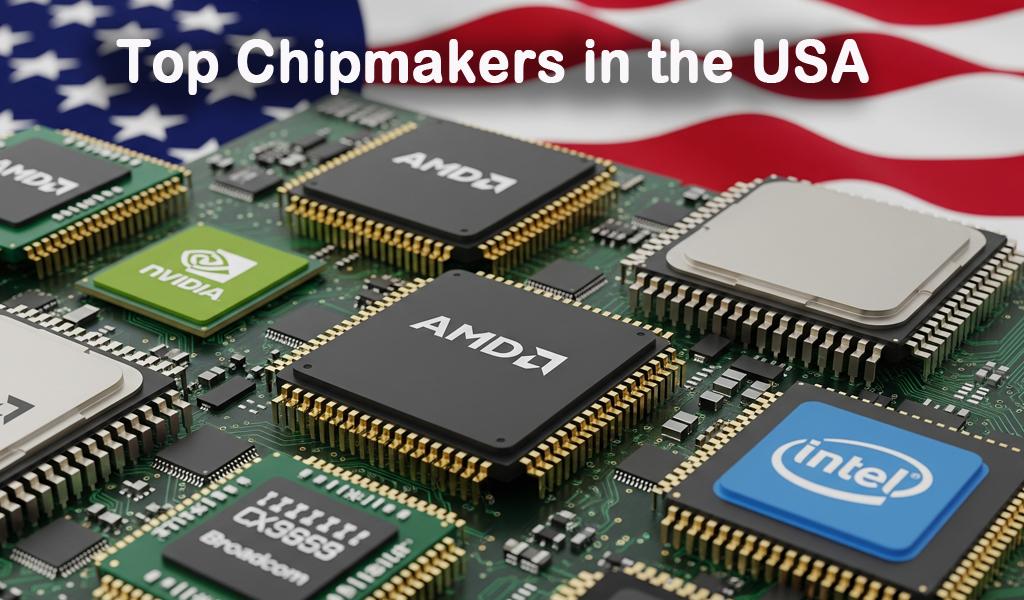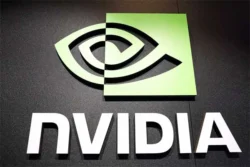The United States stands as a global leader in the semiconductor industry, driving innovation across artificial intelligence (AI), data centers, 5G, and Internet of Things (IoT) technologies. In 2025, the top US chipmakers—Nvidia, Intel, Broadcom, Qualcomm, and AMD—are at the forefront of this technological revolution, powering devices from smartphones to autonomous vehicles. Their performance in the second quarter of 2025 reflects a dynamic industry landscape, with significant growth driven by AI and diversified applications, alongside challenges such as geopolitical tensions and supply chain complexities. This article provides an in-depth analysis of these companies’ financial performance, focusing on their Q2 2025 revenue, estimated market share, and profitability, offering insights into their competitive positions and future prospects.
The semiconductor industry is experiencing unprecedented growth, with global sales projected to reach $697 billion in 2025, according to Deloitte Insights. American companies, which account for a significant portion of the global market’s capitalization, are pivotal in shaping this trajectory. The rise of generative AI, 5G connectivity, and IoT applications has fueled demand for advanced chips, creating both opportunities and challenges for US chipmakers. By examining the latest financial data and strategic initiatives of Nvidia, Intel, Broadcom, Qualcomm, and AMD, this analysis highlights their roles in the industry, their financial health, and the factors influencing their market positions in 2025.
Table of Contents
Financial Performance of Top US Chipmakers
The following table summarizes the Q2 2025 financial performance of the top five US chipmakers, including revenue, year-over-year (YoY) revenue growth, adjusted earnings per share (EPS), and key highlights from their earnings reports:
| Company | Revenue (Q2 2025) | YoY Growth | Adjusted EPS (Q2 2025) | Key Highlights |
|---|---|---|---|---|
| Nvidia | $44.1B | +69% | $0.81 | Record revenue driven by AI and data center GPUs; $4.5B charge due to H20 export restrictions to China. |
| Intel | $12.9B | Flat | -$0.10 | Exceeded revenue expectations; impacted by $1.9B in restructuring charges and $800M in impairment charges. |
| Broadcom | $15.0B | +20% | $1.58 | Record revenue with strong AI semiconductor growth ($4.4B, +46% YoY); infrastructure software up 25%. |
| Qualcomm | $10.84B | +15% | $2.85 | Beat expectations; strong growth in automotive (+59%) and IoT (+27%); QCT segment revenue at $9.5B. |
| AMD | $7.7B | +32% | $0.48 | Record revenue driven by EPYC and Ryzen processors; data center revenue up 14% to $3.2B. |
1. Nvidia: The AI Juggernaut
Nvidia reported a record-breaking $44.1 billion in revenue for Q2 2025, a 69% increase from the previous year, according to its earnings release on May 28, 2025. This growth was primarily driven by its dominance in AI and data center GPUs, particularly the H100 and Blackwell chips, which cater to cloud service providers and enterprises. The company’s adjusted EPS was $0.81, slightly below expectations due to a $4.5 billion charge related to export restrictions on its H20 products to China, which also prevented an additional $2.5 billion in revenue. Despite this, Nvidia’s data center segment continues to thrive, with analysts forecasting nearly $42 billion in revenue for Q3 2025. Nvidia’s stock rose 6% in extended trading, reflecting investor confidence in its AI-driven growth.
Intel’s Q2 2025 revenue reached $12.9 billion, flat year-over-year but surpassing analyst expectations of $11.95 billion, as reported on July 24, 2025. The company faced significant challenges, posting an adjusted loss per share of $0.10, impacted by $1.9 billion in restructuring charges and $800 million in non-cash impairment charges. Under new CEO Lip-Bu Tan, Intel is implementing aggressive cost-cutting measures, including a 15% workforce reduction, aiming for approximately 75,000 employees by year-end. The data center and AI segment showed modest growth, contributing $3.9 billion, up 4% YoY. Intel’s Q3 guidance projects revenue between $12.6 billion and $13.6 billion, with breakeven EPS, signaling cautious optimism for recovery.
3. Broadcom: AI and Software Synergy
Broadcom achieved a record $15.0 billion in revenue for Q2 2025, a 20% YoY increase, as announced on June 5, 2025. Its adjusted EPS of $1.58 beat consensus estimates, driven by robust demand for AI semiconductor solutions, which generated $4.4 billion (up 46% YoY), and infrastructure software, which contributed $6.6 billion (up 25% YoY) due to the successful integration of VMware. Broadcom’s gross margin reached an impressive 79.4%, reflecting a favorable product mix. The company provided strong Q3 guidance, expecting $15.8 billion in revenue, a 21% YoY increase, with AI revenue projected to grow 60% to $5.1 billion. Despite a 4% dip in stock price post-earnings, Broadcom remains a strong performer.
4. Qualcomm: Diversifying Beyond Smartphones
Qualcomm reported $10.84 billion in revenue for Q2 2025, up 15% YoY, surpassing analyst expectations of $10.55 billion, as per its April 30, 2025, earnings release. The company’s adjusted EPS was $2.85, beating forecasts. The Qualcomm CDMA Technologies (QCT) segment generated $9.5 billion, up 18% YoY, with significant growth in automotive (59% YoY) and IoT (27% YoY) sectors, despite a slight shortfall in handset revenue at $6.33 billion. The Qualcomm Technology Licensing (QTL) segment saw a 16% YoY decline to $1.3 billion due to challenges in licensing revenue. Qualcomm’s $2.4 billion acquisition of Alphawave Semi enhances its AI infrastructure capabilities. For Q3, Qualcomm expects revenue between $9.9 billion and $10.7 billion.
5. AMD: Steady Growth in Data Centers and Gaming
AMD reported a record $7.7 billion in revenue for Q2 2025, a 32% YoY increase, as announced on August 5, 2025. Its adjusted EPS of $0.48 met analyst expectations, though it was impacted by an $800 million charge due to export controls on its Instinct MI308 GPUs. The data center segment contributed $3.2 billion, up 14% YoY, driven by EPYC CPUs and Instinct GPUs, while the client and gaming segment grew 69% to $3.6 billion. The embedded segment saw a 4% decline to $824 million. AMD’s Q3 guidance projects revenue of approximately $8.7 billion, with a gross margin of 54%, reflecting confidence in continued growth.
Precise market share data for the US semiconductor industry in 2025 is limited, as most reports focus on global markets or market capitalization. However, based on Q2 2025 revenue figures and industry insights, we can estimate relative market positions within the US market, which is approximated at $498 billion (71.5% of the global $697 billion market, per Deloitte Insights).
- Nvidia: With $44.1 billion in Q2 revenue, Nvidia likely holds a significant share, estimated at around 8-10% of the US market, driven by its 80% dominance in the data center GPU market. Its leadership in AI chips, used by major cloud providers like AWS and Microsoft, solidifies its position.
- Intel: Intel’s $12.9 billion revenue suggests a market share of approximately 2-3%, primarily in CPUs for PCs and servers. Its share has declined due to competition from AMD and Nvidia, but it remains a key player in traditional computing.
- Broadcom: Broadcom’s $15.0 billion revenue indicates a market share of about 3%, with strength in AI networking and infrastructure software. Its partnerships with hyperscale cloud providers enhance its position.
- Qualcomm: Qualcomm’s $10.84 billion revenue points to a market share of roughly 2%, with leadership in mobile chipsets and growing presence in automotive and IoT markets.
- AMD: AMD’s $7.7 billion revenue suggests a market share of about 1.5%, with increasing traction in data centers (EPYC CPUs and Instinct GPUs) and gaming (Ryzen processors).
These estimates are approximate, as market share varies by segment (e.g., GPUs, CPUs, mobile chips) and global competition from companies like TSMC and Samsung. The combined Q2 2025 revenue of these five companies ($90.54 billion) represents a significant portion of the US market, underscoring their dominance.
Profitability Trends
Profitability reflects the diverse business models and market dynamics of these chipmakers:
- Nvidia: Despite a $4.5 billion charge, Nvidia’s adjusted EPS of $0.81 and a 2024 net profit margin of 55.9% highlight its high-margin AI chip business. Its gross margin remains strong, driven by premium pricing for GPUs.
- Intel: A negative adjusted EPS of -$0.10 and a 2024 net profit margin of -35.3% reflect significant challenges, including $1.9 billion in restructuring costs and $800 million in impairment charges. Intel’s focus on cost reduction aims to improve profitability.
- Broadcom: An adjusted EPS of $1.58 and a gross margin of 79.4% demonstrate robust profitability, supported by high-margin AI chips and software revenue from VMware.
- Qualcomm: An adjusted EPS of $2.85 and strong growth in automotive and IoT segments indicate healthy profitability, despite a decline in licensing revenue. Its diversified portfolio supports stable margins.
- AMD: An adjusted EPS of $0.48 and a gross margin of 54% (excluding export control charges) show improving profitability, driven by high-demand data center and gaming products.
Industry Trends and Drivers
The US semiconductor industry is shaped by several key trends:
- AI and Data Centers: Deloitte estimates that generative AI chips will account for over $150 billion in global sales in 2025, with Nvidia and Broadcom leading the charge. AMD is also gaining traction with its Instinct GPUs.
- 5G and IoT: Qualcomm’s leadership in 5G chipsets and AMD’s advancements in edge computing position them to benefit from growing connectivity demands.
- CHIPS and Science Act: The US government’s $39 billion in incentives is expected to triple domestic chip manufacturing capacity by 2032, benefiting Intel and others investing in US facilities.
- Global Competition and Supply Chain Risks: While US companies dominate chip design, most manufacturing occurs in Asia, creating vulnerabilities. Geopolitical tensions, such as export controls to China, have impacted Nvidia and AMD.
Future Outlook
The US semiconductor industry is poised for robust growth, with global sales projected to reach $697 billion in 2025. Key outlooks for each company include:
- Nvidia: Expects nearly $42 billion in Q3 revenue, driven by continued AI demand. Its Blackwell NVL72 rack shipments are set to surge, positioning it for sustained leadership.
- Intel: Projects Q3 revenue of $12.6-$13.6 billion, with breakeven EPS. Its focus on cost-cutting and the Intel 18A technology aims to restore competitiveness.
- Broadcom: Forecasts $15.8 billion in Q3 revenue, with AI revenue growing 60% YoY. Its diversified portfolio and VMware integration ensure strong growth.
- Qualcomm: Anticipates Q3 revenue of $9.9-$10.7 billion, with growth in automotive and IoT. Its acquisition of Alphawave Semi enhances its AI infrastructure capabilities.
- AMD: Guides Q3 revenue at $8.7 billion, with a 54% gross margin. Its focus on AI and data center products positions it for double-digit growth in 2025.
Conclusion
The top US chipmakers—Nvidia, Intel, Broadcom, Qualcomm, and AMD—demonstrate diverse performance in Q2 2025, with Nvidia leading in revenue and profitability due to its AI dominance. Broadcom and Qualcomm show strong growth in AI and diversified segments, while AMD continues to gain market share. Intel faces challenges but is taking steps toward recovery. As the semiconductor industry grows, driven by AI, 5G, and IoT, these companies will play pivotal roles in shaping the future of technology, navigating global competition and supply chain complexities.







